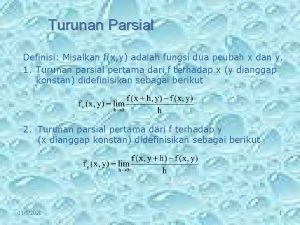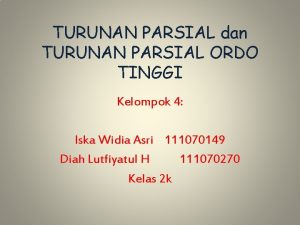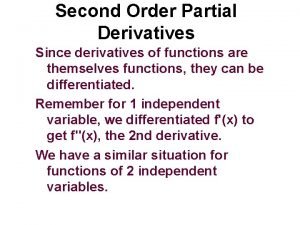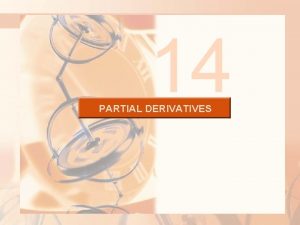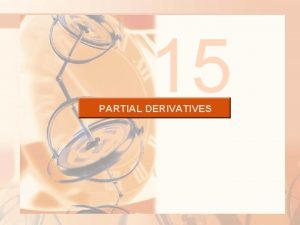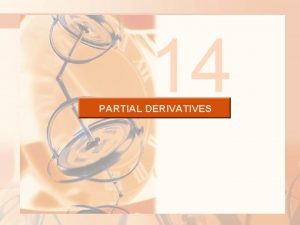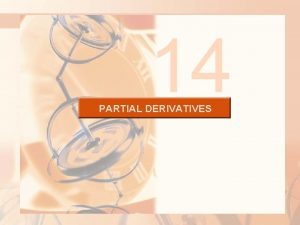Section 15 3 Partial Derivatives PARTIAL DERIVATIVES If










- Slides: 10

Section 15. 3 Partial Derivatives

PARTIAL DERIVATIVES If f is a function of two variables, its partial derivatives are the functions fx and fy defined by

NOTATIONS FOR PARTIAL DERIVATIVES If z = f (x, y), we write

RULE FOR FINDING PARTIAL DERIVATIVES OF z = f (x, y) 1. To find fx , regard y as a constant and differentiate f (x, y) with respect to x. 2. To find fy , regard x as a constant and differentiate f (x, y) with respect to y.

FUNCTIONS OF MORE THAN TWO VARIABLES There analogous definitions for the partial derivatives of functions of three or more variables.

GEOMETRIC INTERPRETATION OF PARTIAL DERIVATIVES Consider the surface S whose equation is z = f (x, y). The plane y = b intersects this surface in a plane curve C 1. The value of fx(a, b) is the slope of the tangent line T 1 to the curve at the point P(a, b, f(a, b)). Similarly, the plane x = a intersects the surface in a plane curve C 2 and fy(a, b) is the slope of the tangent line T 2 to the curve at the point P(a, b, f(a, b)).

SECOND PARTIAL DERIVATIVES If f is a function of two variables, then its partial derivatives fx and fy are also functions of two variables, so we can consider their partial derivatives ( fx)x , ( fx)y , ( fy)x , and ( fy)y , which are called the second partial derivatives of f.

NOTATION FOR THE SECOND PARTIAL DERIVATIVES If z = f (x, y), we use the following notation:

CLAIRAUT’S THEOREM Suppose that f is defined on a disk D that contains the point (a, b). If the functions fxy and fyx are both continuous on D, then fxy(a, b) = fyx(a, b)

HIGHER ORDER DERIVATIVES If f is a two variable function, partial derivatives of order 3 and higher can be defined. Some examples would be fxxx , fxyyx , etc. Using Clairnaut’s Theorem, we can show that fxyy = fyxy = fyyx if these functions are continuous and fxxy = fxyx = fyxx if these functions are continuous.
 Give geometric interpretation of partial derivatives
Give geometric interpretation of partial derivatives Turunan parsial f(x y)
Turunan parsial f(x y) Contoh turunan parsial pertama
Contoh turunan parsial pertama Second order partial derivative
Second order partial derivative Rumus turunan rantai
Rumus turunan rantai Tree diagram partial derivatives
Tree diagram partial derivatives Example of full section
Example of full section Hidden lines are not generally omitted in a sectional view
Hidden lines are not generally omitted in a sectional view Sectional view definition
Sectional view definition Work and energy section 2 describing energy
Work and energy section 2 describing energy Chapter 10 meiosis 1 and meiosis 2
Chapter 10 meiosis 1 and meiosis 2

